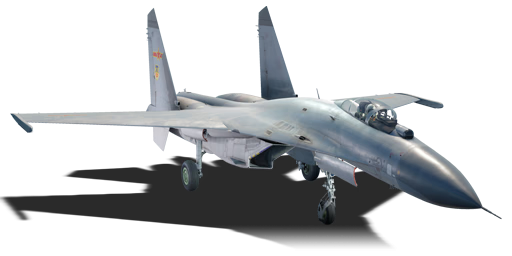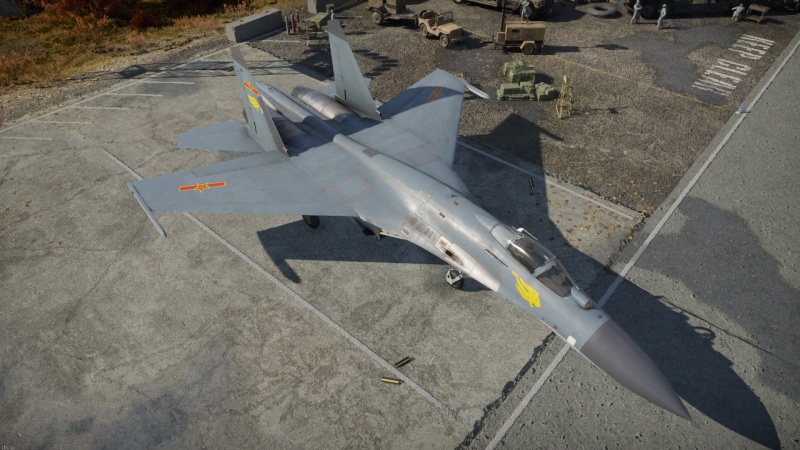J-11
Contents
Description
The J-11 (歼-11型歼击机; NATO Codename: Flanker-B), aka Su-27SK by Sukhoi or 苏-27 in PLAAF manuals, is one of the main composition of modern PLAAF's interceptor fleet since the early 1990s as the overseas solution to upgrade the outdated-PLAAF. By 1989, soon after the improving of Sino-Soviet relationships and the nationwide riots during the economic reform, the only viable solution to upgrade PLAAF was from USSR due to the subsequence embargo imposed by NATO countries; a group of military staffs of PLAAF soon departed for USSR to import the latest interceptors of USSR. Initially, the VVS promoted the MiG-29 to Chinese generals during their visit to Kubinka Airbase, but the generals soon spotted the state-of-the-art interceptor - Su-27S - in the airbase and later crash of the Fulcrum during demonstration flight made PLAAF go for the Flanker. After series of meetings and an interesting behind-the-scene story, the deal was set to purchase the 38th and 39th batches of Su-27S at around USD $1 Billion for 24 jets (18 Su-27SK and 6 UBK twin-seater) and 22 jets respectively. After the fall of Soviet Union, PLAAF saw the possibilities to purchase the production license of Su-27SK in 1993. After threats for no further jets would be ordered from KnAAPO and a long negotiation with the now-Russia Federation, 200 Su-27SK would be assembled by SAC within 15 years since 1996; the licensed Su-27SK, now called J-11A would increase domestic production rate through the 5 batches. The design of Flanker alongside with its blueprints and punched tapes were further refined by Chinese engineers with the help of CAD, revising the redundancies on the original design and eventually set the foundation for J-11B (Flanker-L) and future Flanker derivatives.
Introduced in Update "Air Superiority" as part of the upgrade, J-11 shares identical performance to its Soviet counterpart even though being an export variant; thanks to its well refined aerodynamic design, power engines, loads of A-A weaponries and sufficiently powerful radar/IRST, J-11 leads PLAAF into the current apex of air battles. While its sheer size and inferior electronics can be a problem in different occasions, J-11 will not disappoint players with its iconic features.
General info
Flight performance
Describe how the aircraft behaves in the air. Speed, manoeuvrability, acceleration and allowable loads - these are the most important characteristics of the vehicle.
| Characteristics | Max speed (km/h at _,___ m) |
Max altitude (metres) |
Turn time (seconds) |
Rate of climb (metres/second) |
Take-off run (metres) | |||
|---|---|---|---|---|---|---|---|---|
| AB | RB | AB | RB | AB | RB | |||
| Stock | ___ | ___ | 16000 | __._ | __._ | __._ | __._ | ___ |
| Upgraded | ___ | ___ | __._ | __._ | __._ | __._ | ||
Details
| Features | |||||
|---|---|---|---|---|---|
| Combat flaps | Take-off flaps | Landing flaps | Air brakes | Arrestor gear | Drogue chute |
| _ | _ | _ | _ | _ | _ |
| Limits | ||||||
|---|---|---|---|---|---|---|
| Wings (km/h) | Gear (km/h) | Flaps (km/h) | Max Static G | |||
| Combat | Take-off | Landing | + | - | ||
| 0 | 700 | ___ | ___ | ___ | ~__ | ~__ |
| Optimal velocities (km/h) | |||
|---|---|---|---|
| Ailerons | Rudder | Elevators | Radiator |
| < ___ | < ___ | < ___ | - |
Engine performance
| Engine | Aircraft mass | |||||
|---|---|---|---|---|---|---|
| Engine name | Number | Basic mass | Wing loading (full fuel) | |||
| _____ | _ | _,___ kg | ___ kg/m2 | |||
| Engine characteristics | Mass with fuel (no weapons load) | Max Gross Weight | ||||
| Weight (each) | Type | _m fuel | __m fuel | __m fuel | ||
| ___ kg | ___ | _,___ kg | _,___ kg | _,___ kg | _,___ kg | |
| Maximum engine thrust @ 0 m (RB/SB) | Thrust to weight ratio @ 0 m (___%/WEP) | |||||
| Condition | 100% | ___%/WEP | _m fuel | __m fuel | __m fuel | MGW |
| Stationary | ___ kgf | ___ kgf | _.__ | _.__ | _.__ | _.__ |
| Optimal | ___ kgf (_ km/h) |
___ kgf (_ km/h) |
_.__ | _.__ | _.__ | _.__ |
Survivability and armour
By 1980s, to further reduce the weight, most interceptors were not equipped with extra armor plates for both the pilot and critical components; this is no exception for the Flanker series, thus the pilot can face fatal hits from both autocannons or missile shrapnel.
Meanwhile, all the 5 fuel tanks onboard are self-sealed, meaning that with the help of researchable fire extinguishers, J-11 can save itself from fatal structural failure in case of a fire.
Modifications and economy
Armaments
| Ballistic Computer | ||||
|---|---|---|---|---|
| CCIP (Guns) | CCIP (Rockets) | CCIP (Bombs) | CCRP (Bombs) | Lead indicator |
| |
|
|
|
|
Offensive armament
The J-11 is armed with:
- 1 x 30 mm GSh-30-1 cannon, wing root-mounted (150 rpg)
- 96 x large calibre countermeasures
Suspended armament
Describe the aircraft's suspended armament: additional cannons under the wings, bombs, rockets and torpedoes. This section is especially important for bombers and attackers. If there is no suspended weaponry remove this subsection.
Usage in battles
Describe the tactics of playing in the aircraft, the features of using aircraft in a team and advice on tactics. Refrain from creating a "guide" - do not impose a single point of view, but instead, give the reader food for thought. Examine the most dangerous enemies and give recommendations on fighting them. If necessary, note the specifics of the game in different modes (AB, RB, SB).
Pros and cons
Summarise and briefly evaluate the vehicle in terms of its characteristics and combat effectiveness. Mark its pros and cons in the bulleted list. Try not to use more than 6 points for each of the characteristics. Avoid using categorical definitions such as "bad", "good" and the like - use substitutions with softer forms such as "inadequate" and "effective".
Pros:
Cons:
History
The Komsomolets from Far East
The Su-27 (NATO: Flanker) series were one of the top secrets of the Soviet Union since its introduction in 1985 with the PVO (Su-27P interceptor), which was deemed not-for-sale during the early days of its service as the USSR promotes their MiG-29 series to their allies and potential customers. By May 1989, Mikhail Gobachev made his historical visit to Mainland China amid Chinese's nationwide protests for reform; however, the protests soon escalated to riots and resulted with the sanctions from NATO countries for any further military projects. Yevgeny Shaposhnikov, the last Minister of Defense in future, saw the possibilities to sell fighter jets to Mainland China. After the halt of J-8II Project 8-2 and the commence of Project 8-3, PLAAF has dire need for new interceptors to fill in the gap as ROCAF would soon acquire Mirage 2000-5 and F-16A Block 20; a team of general staff led by Liu Huaqing (刘华清) went to USSR in May 1990 and for the purchase of Soviet fighter jets as the Project 90-6 (906工程). During the talks, Chinese knew the existence of PVO and VVS' Flankers and changed their mind as soon as the general staffs saw the Flanker in Kubinka Airbase; soon after the crash of a MiG-29 during demonstration flight later in September, Flanker became the obvious choice for PLAAF general staffs.
There was a very interesting story behind the negotiations: according to the memories from Lin Hu (林虎), the vice-commander of PLAAF at the time, to defeat the "Ustinov's Rule", named after Dmitriy Feodorovich Ustinov (ex-Minister of Defense of USSR) where Soviet general staffs would use vodka as a way to negotiate for military aids/sales, PLAAF general staff found an officer who is "immune to alcohol" and eventually "took down" all Soviet general staffs in Beijing, earning a discounted price for the Flankers.
Soon after the negotiations, USSR general staffs said there were possibilities to export Flankers to Mainland China; before the collapse of the Red Giant, Soviet Union agreed for the sales of 18 Su-27SK and 6 of its twin-seater variant, Su-27UBK at US $1 billion as the 38th batch of Su-27 produced by KnAAPO (Komsomolsk-on-Amur Aircraft Plant); these jets were all delivered in November 1992. Soon after the introduction of Flankers in PLAAF service, PLAAF went for the production license of Su-27S and threatened the Russians with no further orders after the 39th batch (22 jets); this later led to a long negotiation since August 1993 and eventually set the deal in December 1996, where 200 Su-27SK would be produced by SAC within 15 years. SAC would receive the CKD kits of Su-27SK from KnAAPO to be assembled locally, while future jets would be SKD kits with progressive rate on domestic parts; the Project 11 (11号工程) lead by Li Ming (李明; chief engineer of J-8II) soon received the documents in 1995 for the preparation of domestic assembly, the engineer team translated the documents for a year. With the manufacture equipment and SKD kits delivered to Shenyang in Spring of 1998, SAC assembled a complete jet with the help of Russian engineers and the first domestic assembled Su-27SK, now J-11A "Blue 39" with batch number 0001, soared into the skies on 1st September, 1998, marking one of the page of cooperation between Mainland China and Russia 4 decades after the split.
The J-11A series would be produced for another 4 batches (01xx to 04xx) before SAC finalized and digitalized the Flanker for domestic improvements, which would later known as the J-11B (Flanker-L) since 2006; while some J-11A received domestic and Belarusian upgrades for upgraded FCS and avionics. The Su-27SK and J-11A have been decommissioned by 2020s, likely been replaced by Chinese Flankers; while the Su-27UBK are still in service in small quantities as lead-in trainers for units operating Flankers.
Media
Excellent additions to the article would be video guides, screenshots from the game, and photos.
See also
Links to the articles on the War Thunder Wiki that you think will be useful for the reader, for example:
- reference to the series of the aircraft;
- links to approximate analogues of other nations and research trees.
External links
Paste links to sources and external resources, such as:
- topic on the official game forum;
- other literature.
| China jet aircraft | |
|---|---|
| Fighters | J-2 · J-4 · Shenyang F-5 · J-6A · J-7II · J-7D · J-7E · J-8B · J-8F · J-11 |
| Strike aircraft | Q-5 early · Q-5A · Q-5L · A-5C · JH-7A |
| Bombers | H-5 |
| American | ␗F-84G-21-RE · ␗F-84G-31-RE · ␗F-86F-30 · ␗F-86F-40 · ␗F-100A · ␗F-100F · ␗F-104A · ␗F-104G · ␗F-5A · ␗F-5E · ␗F-16A MLU |
| Soviet | ␗MiG-9 · ␗MiG-9 (l) |





